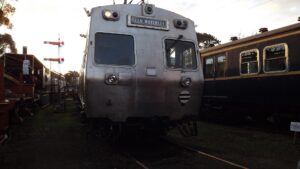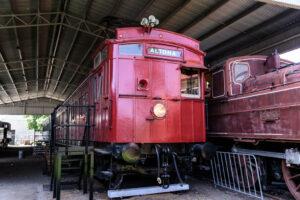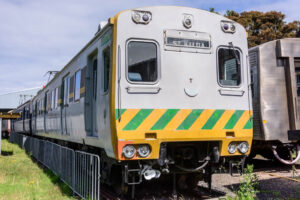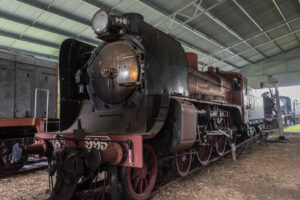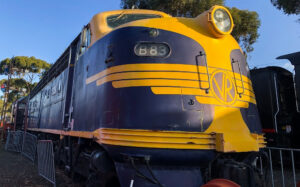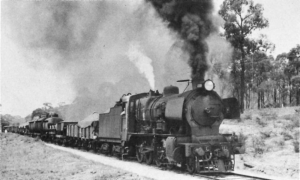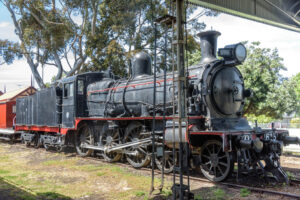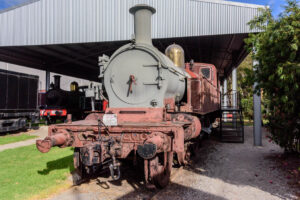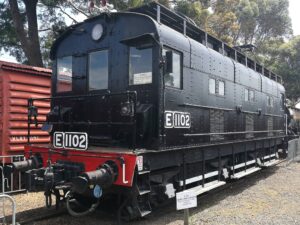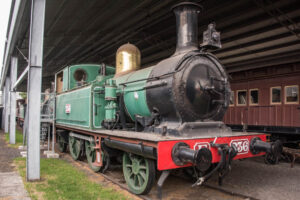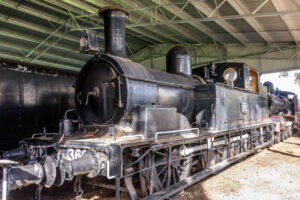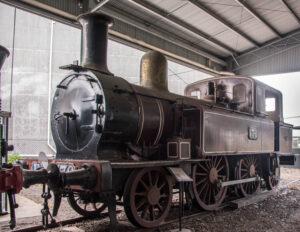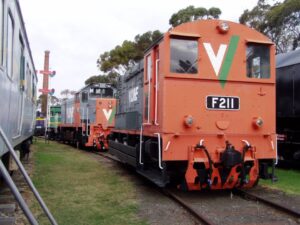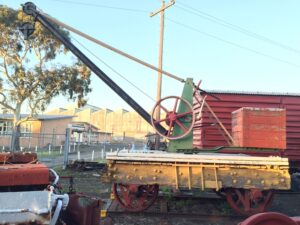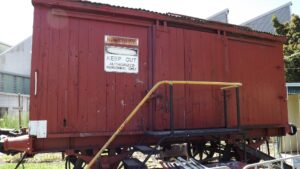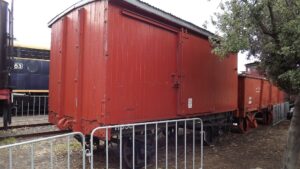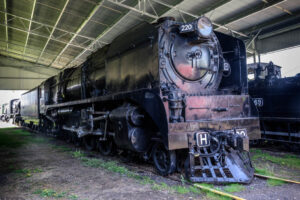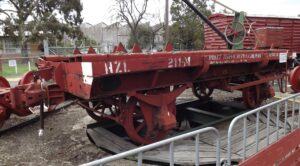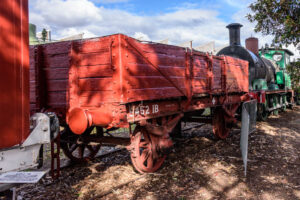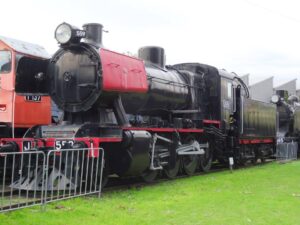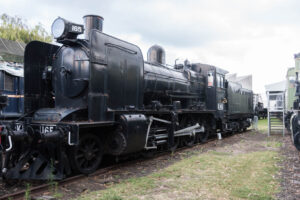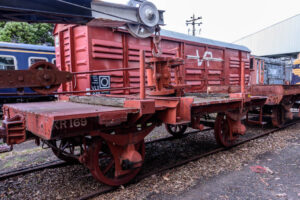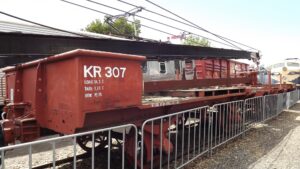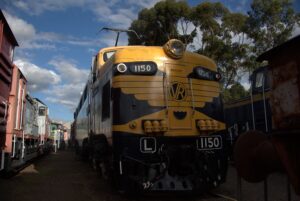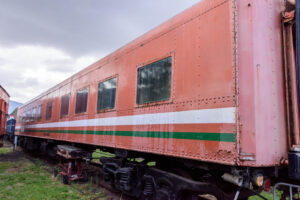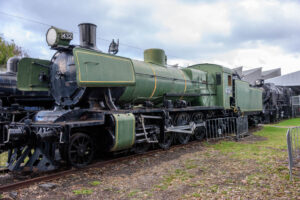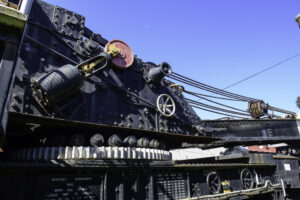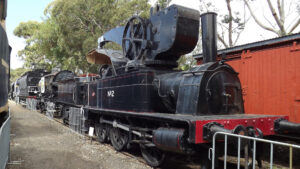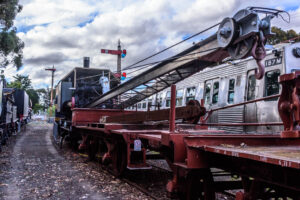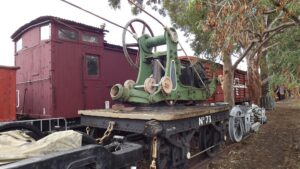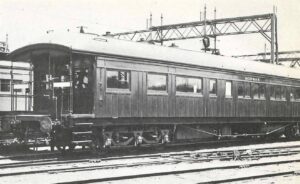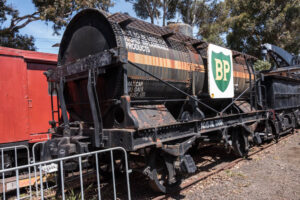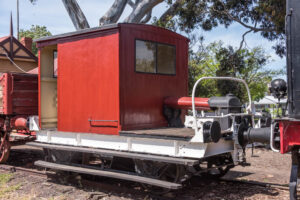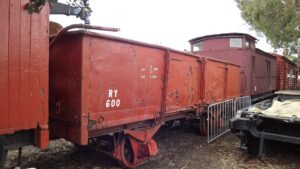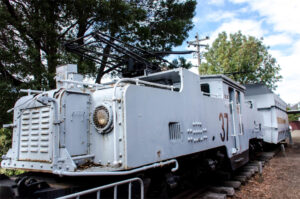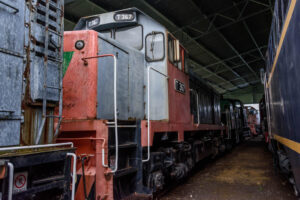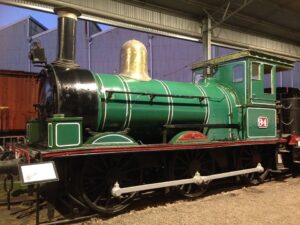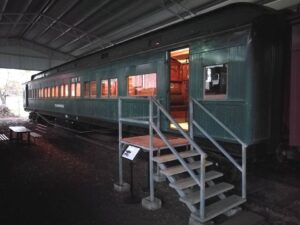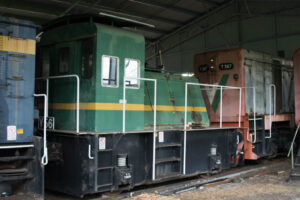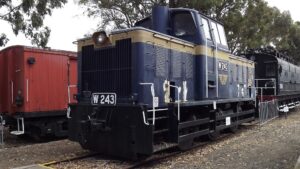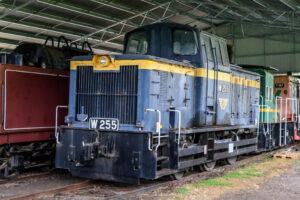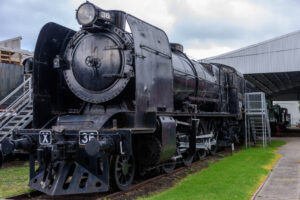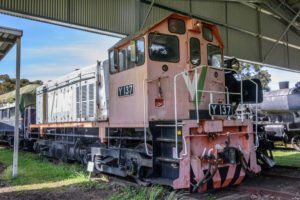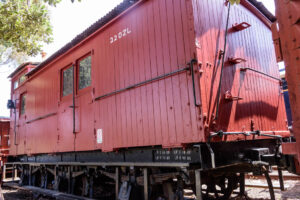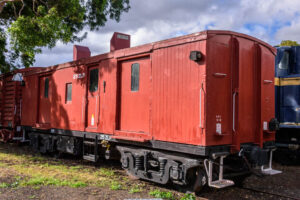The Railway Museum contains Victoria’s most extensive collection of steam locomotives, as well as a number of diesel and electric locomotives, electric suburban carriages, country and interstate passenger carriages, freight wagons, breakdown cranes, and more…
Constructed by private builders Wright and Edwards in 1880, subsequently reclassed as ABAB, AB, B until withdrawn in 1941.
Stripped and converted to Way and Works van 10WW in 1942, and finally retired in 1968.
"Hitachi" type carriage constructed by Martin and King of Bayswater, with electrical equipment supplied by Hitachi Japan and fitted at Newport.
187M was delivered to Victorian Railways in May 1979 and withdrawn in 2004.
This was t
Read More
Second-series "Blue Harris" suburban carriage.
Constructed at Newport Workshops, entering service in August 1968. Withdrawn in June 1988 with the rest of the Harris fleet.
8M is a rare example of an a Swing Door-type Melbourne suburban electric carriage.
When Melbourne's suburban rail network was electrified in the late 1910s and early-to-mid 1920s, the newly-introduced electric trains proved to be a sig
Read More
Originally built in 1964 as 744M, to the same design as 795M.
Extensively stripped and modified by Commonwealth Engineering of Dandenong in 1982 to have the same controller, desk layout, airconditioning and interior as the \"Comeng Sup
Read More
Constructed by Newport Workshops and entered service in August 1913 as A 848.
It was modified with a superheated boiler, smoke deflectors, and renumbered A2 884 in the early 1930s, and retired in 1963.
Of the 125 constructed with outside St
Read More
Constructed at Newport Workshops in May 1916 and retired in 1963.
A2 995 displays the Walscheart\'s valve gear fitted to the last 60 members of the class. Exhibit A2 884 shows the earlier Stephenson\'s Valve Gear fitted to the oth
Read More
A member of the first class of mainline diesel electric locomotives to work on the Victorian Railways. All were constructed by Clyde Engineering, Granville NSW between 1952 and 1954.
B83 entered service in December 1953, and was retired in
Read More
Constructed at Newport Workshops and entered service in early 1922. It was retired in 1962.
When built the C class was the heaviest and most powerful steam locomotives in Australia.
C10 was converted from coal to oil burning in August 1946.
Read More
Constructed by Beyer Peacock of England in 1911, to the DD design of the Victorian Railways. It is similar to exhibit D3635, but with a smaller boiler.
D2604 was sold to Australian Paper Manufacturers in 1956, and was used as a shunter at t
Read More
The D3 class were introduced in 1902 as the DD class, and were later reclassed to D1, D2 and D3 as modifications were made.
The class were constructed by a number of manufacturers, including Thompson\'s Foundry Castlemaine, Walker\
Read More
Constructed by Newport Workshops in 1910.
A modification of the DD class design, shown by exhibits D2 604 and D3 635. All class members were built by Newport Workshops.
This type mainly saw service as suburban passenger engines prior to ele
Read More
Following the electrification of Melbourne's suburban area and an increase in local freight the Victorian Railways constructed 2 new electric locomotives with the same electrical equipment as the suburban passenger trains.
These proved
Read More
Built in 1893 by David Munro, South Melbourne. Used as a suburban passenger engine until electrification of the network. Used as a shunter at Newport from 1926 until retirement in 1953.
Constructed by David Munro workshops.
Originally identical in appearance to exhibit E236, but was modified by the Victorian Railways to 0-6-2 wheel configuration. ]
E369 ended service as Newport Workshops yard pilot in 1972.
Built in 1876 by Phoenix Foundry, Ballarat. Originally built as a tender locomotive, then converted circa 1911 to a tank locomotive. Known as motors, these locomotives would pull a single passenger carriage on services such as Burnley-Darli
Read More
One of 6 locomotives ordered by State Electricity Commission of Victoria with the Victorian Railways F class order.
Built by English Electric Dick Kerr Works, Stafford England.
F211 was delivered to the SEC in March 1953 and purchased by Vi
Read More
Constructed at Newport Workshops in 1893. Modifed to use automatic coupler, but unusually retained buffers which are not required for auto couplers.
Used in Race Service from 1935, and retired in 1962.
In use as maintenance equipment stora
Read More
Built at Newport Workshops in 1897. Used as a maintenance van for electrical overhead equipment from 1918 onwards and retired on 1974.
Retains coupling hook for 3-link coupling.
Photo by Andrew Henderson
Constructed at Newport Workshops in 1941 and retired in 1956. The largest engine constructed by the Victorian Railways, and believed to be the largest non-articulated locomotive in the Southern Hemisphere.
3 of this class were to be built t
Read More
Constructed in 1905 as an IA open wagon, modified and renumbered to HR 75 in 1956 to carry one Tait or Y Class Diesel bogie between Jolimont Workshop and Bendigo Workshop, where they could be inspected and repaired.
Modified again in 1986 a
Read More
Constructed in 1890 by a private builder in Spottiswoode (now Spotswood), one of many constructed by a number of independant builders.
Used for all kinds of traffic that could be carried in an open wagon.
Wagon passed to Way and Works Branc
Read More
The last class of steam locomotive ordered by the Victorian Railways, constructed by Vulcan Foundry, Newton-Le-Willows. They were constructed between 1953 and 1954, by which point the B class diesels had also been delivered and were proving
Read More
A total of 53 K class were constructed in batches between 1922-1923, and 1940-1946 at the Newport Workshops.
K165 entered service in May 1941, and was withdrawn in 1968.
These were versatile and popular locomotives that could be seen runnin
Read More
25 L class locomotives were constructed by English Electric and imported between 1953 / 1954.
L1150 was the first of the class and entered service in April 1953.
The class were designed for use hauling briquettes and brown coal from the Mor
Read More
Constructed in February 1939 for use on the Spirit of Progress, the Victorian Railways flagship train between Melbourne and Albury. It was one of three buffet cars constructed at the time, the others being named Wimmera and Tanjil.
Converte
Read More
N432 was the last steam locomotive ever built by Newport Workshops, entering service in July 1951 and withdrawn 1966.
N class locomotives were a lengthened and upgraded K class, for use on longer branchline freight services. Most were conve
Read More
Built at Newport Workshops in 1942 as a 60-ton crane.
Heavy "wrecking crane" generally used to clear derailments or other heavy lifting.
Retired by the early 1980s.
Cab can be viewed externally every Museum opening day.
Built by DÜBS and Co of Scotland in 1892, used as a workshop crane until retirement in 1970.
Photo by Andrew Henderson
Constructed Thomas Smith and Sons, Rodley in 1929 (builders number 11003).
Withdrawn 1981.
Used at the Spotswood Workshops to load lengths of rail onto wagons for worksites, and clearing scrap from the Reclamation Depot.
Entered service on the 5th June 1890, renamed "Inspection Car" in 1900.
This car was used by the Railway Commissioners who would travel the state inspecting the network and stations, but also doubled as a "State Car" for
Read More
Constructed at Newport Workshops in 1924.
3000 Gallon capacity.
Removed from service in 1978.
Constructed by North British Locomotive Company of Glasgow, Scotland in 1951.
The R class were to be the "final word" in express passenger steam locomotives. The large wheel diameter and large boiler size were intended to replace
Read More
Constructed at Newport Workshops in 1932, and used on the construction of the Yarrawonga - Oaklands line.
First of a series of "Railtractors", lightweight locomotives built on disused wagon underframes and fitted with a Fordson tr
Read More
Constructed by Clyde Engineering of Granville, NSW between 1957 and 1961.
S308 entered service in January 1988 and ended service 30 years later in July 1988.
These locomotives often ran in pairs on the Overland and Spirit of Progress (and l
Read More
One of 6 locomotives ordered by State Electricity Commission of Victoria with the Victorian Railways F class order.
Built by English Electric Dick Kerr Works, Stafford England.
SEC2 entered service in January 1952 owned by SEC, but believed
Read More
A unique survivor from the once expansive Yallourn Open Cut Mine railway.
This locomotive was constructed for use on the 90cm gauge rail network surrounding the Yallourn brown coal mine, taking mined coal and soil from the pit to the storag
Read More
The T class became the most common diesel locomotives of the Victorian Railways.
Constructed in 5 batches by Clyde Engineering, Granville NSW to varying designs.
T367 entered service in February 1964 as the first of the 3rd order. While pre
Read More
Built in 1884 By Phoenix Foundry, Ballarat. The tender is believed to be a unique survivor of the much earlier W class locomotives, which had been scrapped by the 1920s. T94 became a shunter at the Newport Powerstation and the middle pair o
Read More
Sleeping car with twin-berths, based on the E car design.
Entered service in October 1907 as "Adelaide", renamed "Torrens" in 1910 to match the other cars of this type, named after rivers.
This car was owned jointly by V
Read More
Built in 1956 at the Newport Workshops.
V56 was designed to push suburban train sets through the wash plant at Jolimont Workshops, generally at 1km/h.
It used a Fordson 40hp tractor engine and hydraulic motor, with chain driven axles.
V56 w
Read More
Constructed in 1954 at Newport Workshops as 114VP.
114VP was used on the Standard Gauge line to NSW after 1962, and recoded VLPY in 1980.
Retired from service by 1990.
These vans were used for all kinds of traffic including fruit and vegeta
Read More
Constructed at Newport Workshops in 1966 and retired by the mid-1990s.
These vans were used for all kinds of traffic including fruit and vegetables, newspapers, palletised goods etc.
Constructed by Tulloch, Rhodes NSW and entered service February 1960.
Ended service as a shunter at Spotswood yard.
Designed as a shunting engine for the many Victorian Railways yards, but also saw service on Werribee passenger services (br
Read More
Constructed by Tulloch, Rhodes NSW and entered service August 1960.
Designed as a shunting engine for the many Victorian Railways yards, but also saw service on Werribee passenger services (briefly) and branchline freight.
The class as a wh
Read More
Entered service in 1908 as a long-distance dining car to the E car design.
In 1938 it was extensively modified and converted to the Medical and Vision Test Car, which travelled to remote parts of the state to provide medical checks for rail
Read More
Built in 1929 at Newport Workshops. Named Gerald A. Dee in preservation after the VR driver who secured its survival and proposed the creation of a railway museum. Designed as a heavey freight locomotive, built with a large tender to run Me
Read More
Constructed by Phoenix Foundry Ballarat, to a design by Kitson and Co of Leeds, in 1889.
The largest and most powerful 0-6-0 steam locomotives in Australia, the class of 32 were used commonly on passenger service around Melbourne before ele
Read More
The Y class locomotives were built for shunting, and branchline freight with roadside shunting. The controls were set up for good visibility and instant response. They became the second most common class of diesel locomotive ordered by the
Read More
Constructed in 1875 as D45 at the former Williamstown Workshops.
Reconstructed in 1954 and removed from service in 1981.
Displays the rare "double roof" applied to some early carriages.
Z vans and their variants were used as guard
Read More
